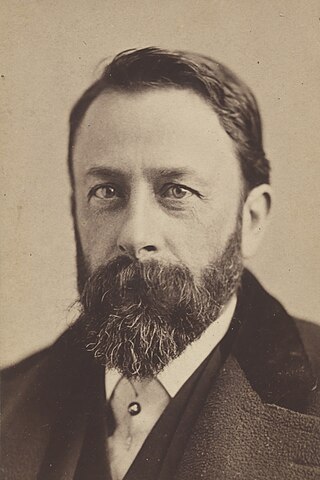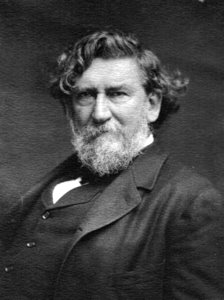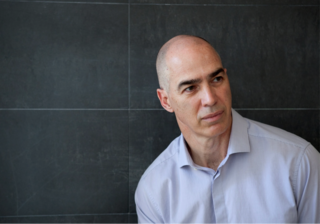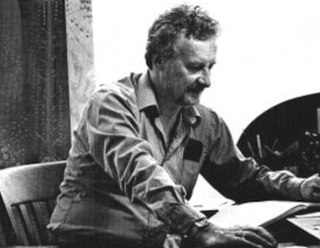Related Research Articles

Albert Bierstadt was a German American painter best known for his lavish, sweeping landscapes of the American West. He joined several journeys of the Westward Expansion to paint the scenes. He was not the first artist to record the sites, but he was the foremost painter of them for the remainder of the 19th century.

Homer Ransford Watson was a Canadian landscape painter. He has been characterized as the painter who first painted Canada as Canada, rather than as a pastiche of European painting. He was a member and president (1918–1922) of the Royal Canadian Academy of Arts, as well as a founding member and first president (1907–1911) of the Canadian Art Club. Although Watson had almost no formal training, by the mid-1920s he was well known and admired by Canadian collectors and critics, his rural landscape paintings making him one of the central figures in Canadian art from the 1880s until the First World War.
The Blue Period comprises the works produced by Spanish painter Pablo Picasso between 1901 and 1904. During this time, Picasso painted essentially monochromatic paintings in shades of blue and blue-green, only occasionally warmed by other colors. These sombre works, inspired by Spain and painted in Barcelona and Paris, are now some of his most popular works, although he had difficulty selling them at the time.

Ellsworth Kelly was an American painter, sculptor, and printmaker associated with hard-edge painting, Color Field painting and minimalism. His works demonstrate unassuming techniques emphasizing line, color and form, similar to the work of John McLaughlin and Kenneth Noland. Kelly often employed bright colors. He lived and worked in Spencertown, New York.
James Alan Davie was a Scottish painter and musician.
William Ronald Smith, known professionally as William Ronald, was an important Canadian painter, best known as the founder of the influential Canadian abstract art group Painters Eleven in 1953 and for his abstract expressionist "central image" paintings. He was the older brother of painter John Meredith (1933–2000).

Thomas Satterwhite Noble was an American painter as well as the first head of the McMicken School of Design in Cincinnati, Ohio.

Haystacks is the common English title for a series of impressionist paintings by Claude Monet. The principal subject of each painting in the series is stacks of harvested wheat. The title refers primarily to a twenty-five canvas series which Monet began near the end of the summer of 1890 and continued through the following spring, though Monet also produced five earlier paintings using this same stack subject. A precursor to the series is the 1884 Haystack Near Giverny.
Allan D'Arcangelo was an American artist and printmaker, best known for his paintings of highways and road signs that border on pop art and minimalism, precisionism and hard-edge painting, and also surrealism. His subject matter is distinctly American and evokes, at times, a cautious outlook on the future of this country.
Joe Goode is an American artist who attended the Chouinard Art Institute in Los Angeles from 1959–1961. Born in Oklahoma City, Oklahoma, Goode made a name for himself in Los Angeles through his cloud imagery and milk bottle paintings which were associated with the Pop Art movement. The artist is also closely associated with Light and Space, a West coast movement of the early 1960s. He currently creates and resides in Los Angeles, California.
Arthur Hill Gilbert was an American Impressionist painter, notable as one of the practitioners of the California-style. Today, he is remembered for his large, colorful canvases depicting meadows and groves of trees along the state's famed 17 Mile Drive. Gilbert was part of the group of American impressionist artists who lived and painted in the artists' colony scene in California at Carmel and Laguna Beach during the 1920s and 1930s.

Paul Feeley was an artist and director of the Art Department at Bennington College during the 1950s and early 1960s.
Andrew Bucci was an American artist from Mississippi.
The Galeries Ontario / Ontario Galleries (GOG), formerly Ontario Association of Art Galleries / Association Ontarienne des Galeries d’Art (OAAG/AOGA), was established in 1968 to encourage development of public art galleries, art museums, community galleries and related visual arts organizations in Ontario, Canada. It was incorporated in Ontario in 1970, and registered as a charitable organization. It is a successor organization to the Southern Ontario Gallery Group founded in 1947, renamed the Art Institute of Ontario in 1952. In December 2020 Ontario Association of Art Galleries / Association Ontarienne des Galeries d’Art (OAAG/AOGA) rebranded to the name Galeries Ontario / Ontario Galleries (GOG) which included new brand identity, logo, and website to better serve art organizations in Ontario and Canada.

Anthony Morse Urquhart, LL.D. was a Canadian painter. He was recognized in the late 1950s and early 1960s as one of Canada's pioneering abstractionists, having been variously linked with the Toronto painters associated with The Isaacs Gallery and The Heart of London group that included Jack Chambers, Greg Curnoe and Murray Favro.
Laylah Ali (born 1968) is a contemporary visual artist known for paintings in which ambiguous race relations are depicted with a graphic clarity and cartoon strip format.

David Klamen is an American artist and academic. He is known for visually diverse paintings that meld technical mastery with postmodern explorations of the processes by which humans understand and interpret experience. Klamen has exhibited across the United States, Europe and Asia, including individual shows at the Museum of Contemporary Art Chicago (MCA), the Chazen Museum of Art and the Cedar Rapids Museum of Art, and major group exhibitions at the Metropolitan Museum of Art, the Art Institute of Chicago, the Museum of Contemporary Art, San Diego, the Indianapolis Museum of Art, and the Crocker Art Museum. His work sits in the permanent collections of the Metropolitan Museum of Art, the Los Angeles Museum of Contemporary Art and the Whitney Museum of American Art, among others. Klamen has been based in Chicago for most of his career, which includes being an educator for over thirty years, primarily at Indiana University Northwest, where he was appointed Founding Dean, School of the Arts in 2018.

Álvaro Casanova Zenteno was a prominent marine painter and of historic naval warfare, a statesman his art is classified as realist, expressionist, classical, and romantic.

John Hall is a Canadian modernist painter from Alberta, known for his highly realistic painting style.

Richard Loving (1924–2021) was an American artist and educator, primarily based in Chicago, Illinois. He gained recognition in the 1980s as a member of the "Allusive Abstractionists," an informal group of Chicago painters, whose individual forms of organic abstraction embraced evocative imagery and metaphor, counter to the dominant minimalist mode. He is most known for paintings that critics describe as metaphysical and visionary, which move fluidly between abstraction and representation, personalized symbolism taking organic and geometric forms, and chaos and order. They are often characterized by bright patterns of dotted lines and dashes, enigmatic spatial fields, and an illuminated quality. In 2010, critic James Yood wrote that Loving's work "mull[ed] over the possibilities of pattern and representation, of narrative and allegory" to attain a kind of wisdom, transcendence and acknowledgement of universals, "seeking understanding of self within the poetics of the physical world."
References
- ↑ Loos, Ted (April 3, 2017). "Chicago to Take the Spotlight With Ambitious 2018 Art Event". New York Times. Retrieved 30 May 2017.
- 1 2 3 4 5 6 7 Art Green: Certain Subjects. New York: Garth Greenan Gallery. 2013. ISBN 9780989890212.
- 1 2 3 Gruber, Terry (1977). "Art Green". Arts Magazine. 51 (9): 16.
- 1 2 Applegate, Judith (1970). "Paris Letter". Art International. 14 (5): 65.
- 1 2 3 4 5 6 7 8 9 10 Enright, Robert (2005). "Green's Party". Border Crossings. 24 (4).
- ↑ Halstead, Whitney (1966). "Chicago". Artforum. 4 (10): 56.
- ↑ Heavy Weather: Art Green Retrospective. Kitchener: Kitchener-Waterloo Art Gallery. 2005. ISBN 0973818018.
- ↑ Schulze, Franz (1966). "Chicago Popcycle". Art in America. 54 (6): 103.
- ↑ Halstead, Whitney (1967). "Chicago". Artforum. 5 (9): 66.
- ↑ Urquhart, Jane (1979). "Waterloo: Art Green". ArtsCanada (226/227): 64.
- 1 2 Adrian, Dennis (1974). "Chicago: Art Green at Phyllis Kind". Art in America. 62 (4): 91–92.
- 1 2 Frank, Peter (1977). "Art Green". Art News. 76 (3): 144.
- 1 2 Johnson, Ken (February 27, 2009). "Art in Review: Art Green". The New York Times. Retrieved 31 May 2017.
- ↑ Argy, Andy (1986). "Art Green". New Art Examiner. 13 (8): 53–54.
- 1 2 Moser, Charlotte (1986). "Art Green". Art News. 85 (4): 142–143.
- ↑ Glatt, Cara (August 18, 1999). "Hairy Who gets up close and personal". Hyde Park Herald: 10.
- ↑ "Delicate Situation - Online Collection". Akron Art Museum. Akron Art Museum. Retrieved 31 May 2017.
- ↑ "Search Collections Results". The Art Institute of Chicago. The Art Institute of Chicago. Retrieved 31 May 2017.
- ↑ "Valparaiso Poetry Review". Valparaiso University. Valparaiso University. Retrieved 31 May 2017.
- ↑ "Search". Canada Council Art Bank. Retrieved 31 May 2017.
- ↑ "Green, Art, Conflicting Evidence, 1974". Dalhousie Art Gallery. Dalhousie Art Gallery. Retrieved 31 May 2017.
- ↑ "Collections". Smart Museum of Art. University of Chicago. Retrieved 31 May 2017.[ permanent dead link ]
- ↑ "Thin Ice". mumok. mumok. Retrieved 31 May 2017.
- ↑ "Collection: Art Green, Rigorous Timidity, 1970". MCA. MCA Chicago. Retrieved 31 May 2017.
- ↑ "Collection Search Results". NGA. NGA. Retrieved 31 May 2017.
- ↑ "The Collection". PAFA. PAFA. Retrieved 31 May 2017.
- ↑ "Pure Fabrication by Art Green". Smithsonian American Art Museum. Smithsonian American Art Museum. Retrieved 31 May 2017.
- ↑ "Face Value". Yale University Art Gallery. Yale University. Retrieved 31 May 2017.
- ↑ "Members since 1880". Royal Canadian Academy of Arts. Archived from the original on 26 May 2011. Retrieved 11 September 2013.